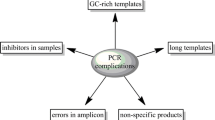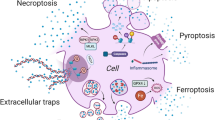Abstract
The degree of nucleolysis is of critical significance for isolation of nuclear matrix (NM) specifically enriched in transcribed DNA sequences, as demonstrated using an example of inactive (c-fos, c-myc, andC κ) and active (p53, albumin, and28S rRNA) genes in resting hepatocytes. The optimal degree of nucleolysis is characterized by degradation of loop domains of chromatin, with the relatively uniform molecular weight distribution of DNA being preserved. Deviation from these parameters leads to nonspecific fragmentation of chromatin in various gene loci and isolation of NM samples nonspecifically enriched with or depleted of transcribed DNA sequences. Under optimal hydrolytic conditions, the transcribed chromatin is more resistant to endogenous DNase attack, which allows selective conservation of its association with the nuclear matrix
Similar content being viewed by others
REFERENCES
Bondar', N.I., Bezrukov, I.F., Sivolob, A.V., and Khrapunov, S.N., Possible Role of Endogenous Nucleases in Structural Arrangement of Chromatin,Nauch. Dokl. Vyssh. Shkoly, Ser. Biol. Nauki, 1992, no. 2, pp. 58-64.
Caserta, M., Camilloni, G., Venditti, S., Venditti, P., and Di Mauro, E., Conformational Information in DNA: Its Role in the Interaction with DNA Topoisomerase I and Nucleosomes,J. Cell Biochem., 1994, vol. 55, pp. 93-97.
Ciejek, E.M., Tsai, M.J., and O'Malley, B.W., Actively Transcribed Genes Are Associated with the Nuclear Matrix,Nature, 1983, vol. 306, no.5943, pp. 607-609.
Counis, M.F. and Torriglia, A., DNAses and Apoptosis,Biochem. Cell. Biol., 2000, vol. 78, no.4, pp. 405-414.
Counis, M.F., Chaudun, E., Arruti, C., Oliver, L., Sanwal, M., Courtois, Y., and Torriglia, A., Analysis of Nuclear Degradation during Lens Cell Differentiation,Cell. Death Differ., 1998, vol. 5, no.4, pp. 251-261.
Donev, R.M., The Type of DNA Attachment Sites Recovered from Nuclear Matrix Depends on Isolation Procedure Used,Mol. Cell. Biochem., 2000, vol. 214, nos.1-2, pp. 103-110.
Dwarakanath, B.S., Wallen, C.A., St. Clair, D.K., and Wheeler, K.T., Characterization of Nuclear Matrices Prepared without Salt Extraction,Anal. Biochem., 1991, vol. 198, no.1, pp. 68-74.
Filippova, G.N., Spitkovskii, D.D., Boikov, P.Ya., and Alesenko, A.V., Expression of Oncogenes in the Rat Liver under Conditions of Template Biosynthesis Uncoupling by Sublethal Doses of Cycloheximide,Mol. Biol.(Moscow), 1989, vol. 23, no.3, pp. 843-850.
Georgiev, G.P.,Geny vysshikh organizmov i ikh ekspressiya(Genes of Higher Organisms and Their Expression), Moscow: Nauka, 1989.
Hanks, S.K. and Riggs, M.G., Selective Insolubility of Activehsp70Gene Chromatin,Biochim. Biophys. Acta1986, vol. 867, no.3, pp. 124-134.
Khodarev, N.N., Ca2+/Mg2+-Dependent Endonuclease as a Component of Enzyme System of Genome Activity: Properties, Specificity, and Possible Biological Role,Doctoral (Biol.) Dissertation, Moscow, 1989.
Khodarev, N.N., Sokolova, I.A., Aleksandrova, S.S., Chupyrina, I.V., and Votrin, I.I., Ca2+/Mg2+-Dependent Endonuclease as a Probe for Detecting Chromatin Changes in Lymphocytes in Chronic Lymphoid Leukemia,Mol. Genet. Mikrobiol. Virusol., 1987, no. 9, pp. 24-27.
Los, M., Neubuser, D., Coy, J.F., Mozoluk, M., Poustka, A., and Schultze-Osthoff, K., Functional Characterization of DNAse X, a Novel Endonuclease Expressed in Muscle Cells,Biochemistry, 2000, vol. 39, no.25, pp. 7365-7373.
Michael, D. and Oren, M., Thep53andMdm2Families in Cancer,Curr. Opin. Genet. Dev., 2002, vol. 12, no.1, pp. 53-59.
Parslow, T.G. and Granner, D.K., Structure of a Nuclease-Sensitive Region inside the Immunoglobin Kappa Gene: Evidence for a Role in Gene Regulation,Nucl. Acids Res., 1983, vol. 11, no.14, pp. 4775-4792.
Pederson, T., Thinking About a Nuclear Matrix,J. Mol. Biol., 1998, vol. 277, pp. 147-159.
Player, A.N. and Kantor, G.J., The Endogenous Nuclease Sensitivity of Repaired DNA in Human Fibroblasts,Mutat. Res., 1987, vol. 184, no.2, pp. 169-178.
Rakowicz-Szulczynska, E.M., Otwiaska, D., Rodeck, U., and Korpovsky, H., Epidermal Growth Factor (EGF) and Monoclonal Antibody to Cell Surface EGF Receptor Bind to the Same Chromatin ReceptorArch. Biochem. Biophys.1989, vol. 268, no.2, pp. 456-464.
Ramotar, D., Auchincloss, A.H., and Fraser, M.J., Nuclear Endo-Exonuclease ofNeurospora crassa.Evidence for a Role in DNA Repair,J. Biol. Chem., 1987, vol. 262, no.1, pp. 425-431.
Shiokawa, D. and Tanuma, S., Characterization of Human DNAse I Family Endonucleases and Activation of DNAse Gamma during Apoptosis,Biochemistry, 2001, vol. 40, no.1, pp. 143-152.
Smith, R.D., Seale, R.L., and Yu, J., Transcribed Chromatin Exhibits an Altered Nucleosomal Spacing,Proc. Natl. Acad. Sci. USA, 1983, vol. 80, no.18, pp. 5505-5509.
Solov'yan, V.T., Andreev, I.O., and Kunakh, V.A., Fractionation of Eukaryotic DNA in Pulse Field: 2. Discrete DNA Fragments and Levels of Chromatin Structural Arrangement,Mol. Biol.(Moscow), 1991, vol. 25, no.6, pp. 1483-1490.
Suck, D. and Oefner, C., Structure of DNAse I at 2.0 A Resolution Suggests a Mechanism for Binding to and Cutting DNA,Nature, 1986, vol. 321, no.6070, pp. 620-625.
Waldeck, W., Fohring, B., Chowdhury, K., Gruss, P., and Sauer, G., Origin of DNA Replication in Papovavirus Chromatin is Recognized by Endogenous Endonuclease,Proc. Natl. Acad. Sci. USA1978, vol. 75, no.12, pp. 5964-5968.
Xanthopoulos, K.G., Prezioso, V.R., Chen, W.S., Sladek, F.M., Cortese, R., and Darnell, J.E., Jr., The Different Tissue Transcription Patterns of Genes of HNF-1, C/EBP, HNF-3, and HNF-4 Protein Factors That Govern Liver-Specific TranscriptionProc. Natl. Acad. Sci. USA, 1991, vol. 88, pp. 3807-3811.
Yaniv, M. and Cereghini, S., Structure of Transcriptionally Active Chromatin,CRC Crit. Rev. Biochem.1986, vol. 21, no.1, pp. 1-26.
Zbarskii, I.B.,Organizatsiya kletochnogo yadra(Organization of the Cell Nucleus), Moscow: Meditsina, 1988.
Author information
Authors and Affiliations
Rights and permissions
About this article
Cite this article
Borisova, N.P., Kostyuk, G.V., Shevchenko, N.A. et al. Endogenous DNases as a Tool for Isolation of Nuclear Matrix: Critical Parameters of Nucleolysis. Biology Bulletin 30, 442–448 (2003). https://doi.org/10.1023/A:1025882115840
Issue Date:
DOI: https://doi.org/10.1023/A:1025882115840




